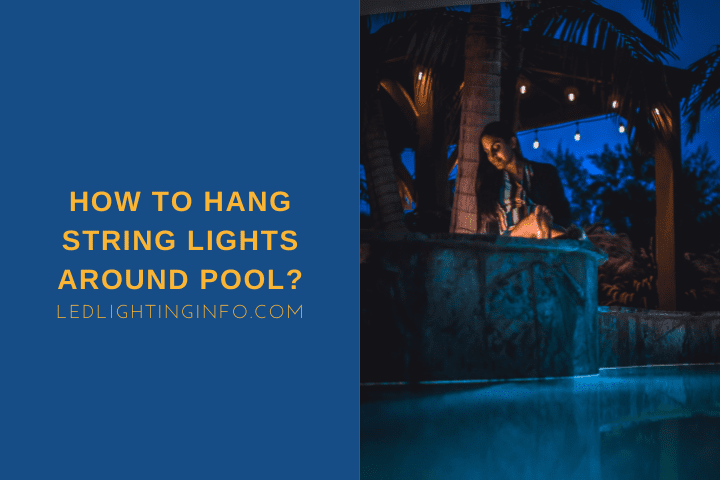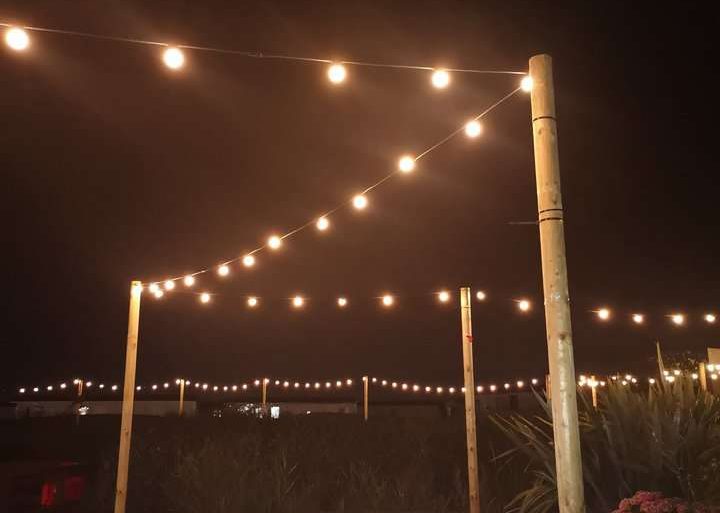You can light up a pool in many ways, with one option being string lights.
String lights are ideal if you’ll spend a good amount of time around the pool, as well as swimming in it.
If you live somewhere where the evenings are warm, then string lights create a fantastic ambiance.
They also make it easier to see any hazards around the pool edge – something that submerged lights won’t do.
To hang string lights around a pool, you’ll need anchor points – you can use any high structure you already have or install support posts. It is safest and easiest to install lights around a pool instead of over it. Lights over a pool should have 10 feet of clearance.
To help you with your own pool lighting project, let’s take a look at:
- Whether you should hang lights over the pool, or around it
- How to hang LED strip lights around a pool
- Whether it’s safe to have LED lights near a pool
Should I Put Lights Around Or Over My Pool?
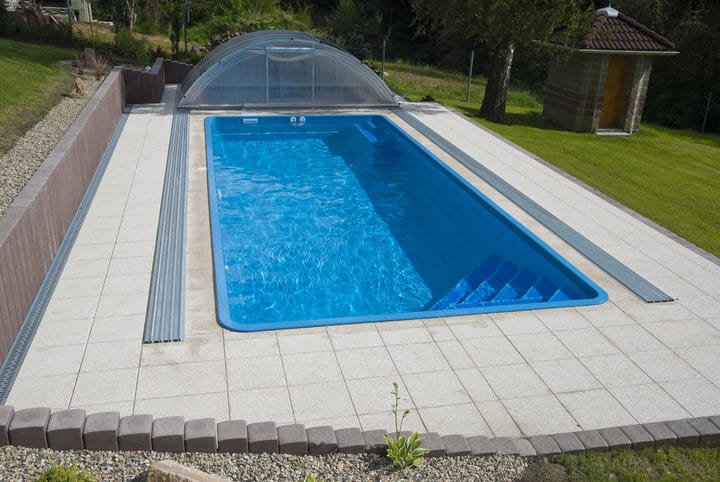
The first thing you’ll want to do when installing lights for your pool is to decide where they go. And your two main options are to have them over the pool or around it.
There’s a lot of inspirational photography on sites like Pinterest that show intricate string light installations hanging over a pool, and they can look pretty cool.
But at the same time, there are some drawbacks to hanging lights directly over a pool. Firstly, installation is a little trickier.
It’s by no means impossible, but you won’t have direct access to the string lights over the water.
You’ll need to lay the string out and carry it around the pool, keeping it elevated out of the water until you can lift them into position.
And if the string gets twists or kinks, it’s harder to undo it. You can’t climb a ladder over the water!
It’s also less safe because there’s a risk of the bulbs getting wet.
While you’ll be buying weatherproof lights that should be sealed against moisture, submerging them in water is still dangerous.
And if you ever had extreme weather that knocked a support pole over, the lights are going straight down into the water.
You’d unlikely swim during a storm, but it could still be dangerous.
Compare that to hanging lights around the pool.
You have easier access to the string lights at all times since you can climb a ladder on the hard surface.
You don’t have to worry about the bulbs dropping into the pool during installation. If a storm is knocking over a support pole, they might not end up in the water (though they still could).
You also have more flexibility over height.
You should keep lights above a pool at least 10 feet from the surface to avoid splashes – but you could drop this to around 8 feet around the pool edge.
Hanging lights around the pool edge also add an extra safety feature since they’ll better illuminate hazards around the sides that you could trip or slip on.
Residual light from over-pool lights will help a little, but lights focusing on the edges will do a better job.
How Do I Hang LED String Lights Around A Pool?
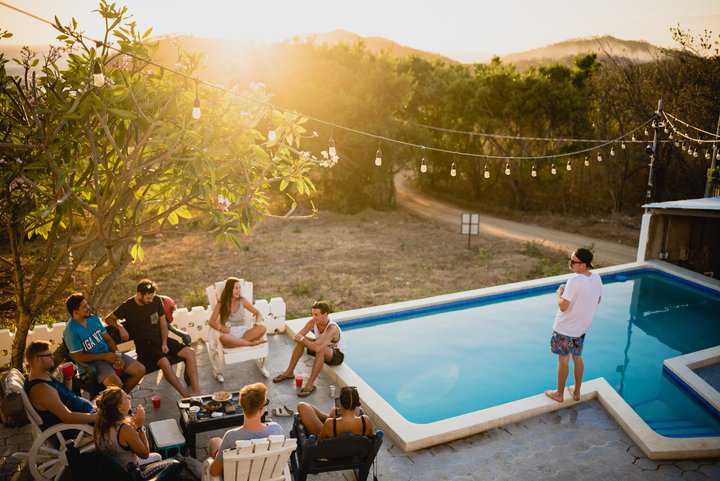
There are many ways you can hang LED string lights around a pool. You have a few things to think about:
- How high you want the lights
- Whether you want them taut, or with a dip
- Where you’re going to anchor them
Height
It’s important to ensure your lights are high enough to keep them away from pool splashes and that they don’t get in your way as you walk under them.
Lights won’t tend to hang down more than 6 inches from the string, so if you aim to have the string 7 feet from the ground, the lights should be around 6.5 feet from the floor.
This might be a little low if you have any taller friends or family, so instead, aim for a height of around 8 feet.
If you choose brighter, larger lights, aim to hang them higher – otherwise, they may feel too bright.
Taut Or Dipped

It’s primarily an aesthetic choice whether you have the string taut or with a dip in the middle, but there are a couple of benefits to having it tight.
Firstly, it makes it easier to measure height. For example, if you know your anchor points are 8 feet tall, your whole string will be.
If you have a dip, the lights may drop to an uncomfortable level.
Plus, taut lights will move less during high winds.
They’ll still shake, but string lights with extra give will have more flex to sway, and the bulbs could even hit each other.
Choose taut if you aren’t swayed a particular way from a design perspective.
Anchor Points
You should choose anchor points that keep the bulbs away from a solid surface.
You might be tempted to take advantage of that fence or wall, but any high winds could smash the bulbs against them.
So look for existing points that have clearance below them. It might be a drainpipe along the side of your home or a pergola.
And where you don’t have an existing point, you’ll want to buy string light poles.
These can be affixed to various surfaces, including decking or earth, but they tend to come in fixed heights.
Pole lights will typically have clips or hooks built in, but otherwise, you’ll also need to buy those to fix your lights in place.
And finally, consider spacing.
For typical LED string lights that you’d use at home, you can normally have between 10 and 15 feet between each anchor point before the weight of the bulbs becomes an issue.
For commercial-grade string lights, which tend to be heavier, that distance is 6-10 feet.
Is It Safe To Have LED Lights Near Pool?
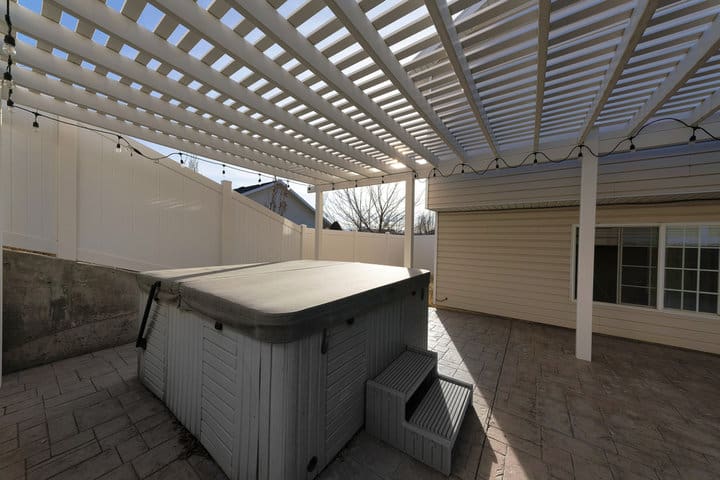
The safety of LED string lights near a pool depends on what type of LED string lights they are.
If they are 120-volt lights that plug straight into the mains, then you should keep them five feet away from the water’s edge, as well as the 10-feet minimum above water level.
That’s because a 120-volt current is enough to kill you, so you must keep the bulbs a sufficient distance away.
They also have to be plugged into an outlet with a ground fault circuit interrupter (GFCI) so that they are cut out as soon as a ground fault is detected.
If your LED string lights are low voltage and plugged into a transformer, the 5-foot distance isn’t as strict, but it would still be recommended.
A 12-volt current is unlikely to kill you. However, it could still cause injury, and any injury, while you’re swimming in a pool, could be potentially even more dangerous.
Don’t assume that, just because your lights are described as weatherproof, they’re OK to be submerged in water as they aren’t.
They are only protected from light splashes of rain in many cases.
Also, if your string lights have fallen 10 feet to land in the pool, there’s a good chance they’re damaged, and any waterproof rating is compromised.
So yes, you can safely use string lights near a pool, but the safest option is to hang them 5 feet away from the edge.
Final Words
String lights are a good option for creating a cozy, relaxing space around the edge of your pool – provided you’re comfortable hanging them at a safe height.
Using some string lights combined with submerged lights will give your outdoor space a gentle glow, ideal for some evening swims in the summer air.
If you have a pool at your home, how do you choose to light it? Or have you considered adding string lights to your patio without a pool?

